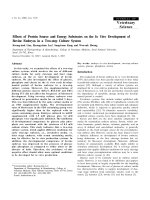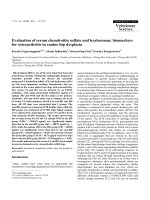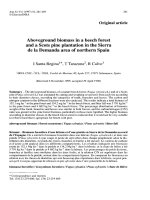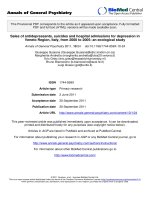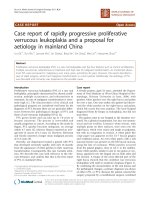review standard architecture frameworks tools hardware and apis available for use in iot development p2 unit 43 internet of things
Bạn đang xem bản rút gọn của tài liệu. Xem và tải ngay bản đầy đủ của tài liệu tại đây (2.07 MB, 48 trang )
<span class="text_page_counter">Trang 1</span><div class="page_container" data-page="1">
ASSIGNMENT 1
Qualification BTEC Level 5 HND Diploma in ComputingUnit number and title Unit 43: Internet of Things
</div><span class="text_page_counter">Trang 3</span><div class="page_container" data-page="3">❒
Summative Feedback:❒❒
Resubmission Feedback:Internal Verifier’s Comments:
</div><span class="text_page_counter">Trang 4</span><div class="page_container" data-page="4">Signature & Date:
</div><span class="text_page_counter">Trang 5</span><div class="page_container" data-page="5">5. API for use in IoT development ... 13
III. Investigate architecture, frameworks,tools, hardware, and API techniques available to develop IoT applications. (P3) ... 14
1. Choose suitable architectural models for the product. ... 14
2. Select frameworks if applicable for the product. ... 15
3. Choose hardware components. ... 16
IV. Determine a specific problem to solve using IoT. (P4)... 20
1. Develop a product development plan. ... 20
2. Define the problem to be solved. ...21
</div><span class="text_page_counter">Trang 6</span><div class="page_container" data-page="6">3. Specify the purpose of the product. ... 22 Conclusion ... 23 References ... 23
</div><span class="text_page_counter">Trang 7</span><div class="page_container" data-page="7">List of Figures
Figure 1. IoT ... 5 Figure 2. Charateristics of IoT ... 7
List of tables
Table 1. components in the project ... 17
</div><span class="text_page_counter">Trang 9</span><div class="page_container" data-page="9">INTRODUCTION
As we know, technology has made significant contributions to human life in fields such as industry, agriculture, transportation, etc. IoT or internet of things also plays an important role in this. In this essay, I will explain the fundamentals of the Internet of Things and investigate several types of IoT capabilities. Next I will learn about the architecture, frameworks, tools, hardware, and standard APIs available for IoT development. Then I will assemble the necessary components to create an IoT application. Finally, I choose a specific problem to solve with IoT and develop a comprehensive project strategy.
I. Explore various forms of IoT functionality on an electronic platform. (P1) 1. What is Io T?
</div><span class="text_page_counter">Trang 10</span><div class="page_container" data-page="10">The Internet of Things (IoT) is a network of physical devices, automobiles, appliances, and other items that have sensors, software, and network connectivity to gather and exchange data. These "smart objects," as they are often known, can vary from basic equipment like smart thermostats to large industrial machines.
The Internet of Things allows these smart gadgets to talk with one another as well as with other internet-connected devices such as smartphones and gateways. This
<small>Figure 1. IoT</small>
</div><span class="text_page_counter">Trang 11</span><div class="page_container" data-page="11">results in a massive network of networked gadgets that can share data and execute various activities on their own. IoT applications are numerous, affecting industries such as manufacturing, transportation, healthcare, agriculture, and others.
2. History of IoT
The history of the Internet of Things (IoT) dates back to the 1980s, when machines were connected via local area networks (LANs) for monitoring and control. In the 1990s, the internet and wireless connectivity technologies such as Wi-Fi and Bluetooth became popular, paving the way for widespread adoption of IoT. The idea of IoT began to be mentioned in the late 1990s and early 2000s, when any processed object equipped with sensors and RFID chips could connect to the internet and share information. From the 2000s onwards, IoT has developed rapidly, with the emergence of technologies such as embedded systems, sensors, wireless connectivity and the cloud. Currently, IoT has expanded into many fields and is applied in healthcare, agriculture, transportation, home automation and many other fields.
</div><span class="text_page_counter">Trang 13</span><div class="page_container" data-page="13">3. Characteristics of IoT
IoT has numerous distinguishing features:
Ambient intelligence: Refers to smart environments that are aware of and responsive to the presence of individuals. These environments possess independent and intelligent entities that can self-organize based on context,
<small>Figure 2. Charateristics of IoT</small>
</div><span class="text_page_counter">Trang 14</span><div class="page_container" data-page="14">circumstances, or surroundings.
Interconnectivity: In the context of the Internet of Things (IoT), there is a seamless ability to connect any object or device to the global information and communication infrastructure.
Services for Things: The IoT offers services specific to objects or devices while adhering to constraints such as privacy protection and ensuring semantic consistency between physical objects and their virtual representations. The
</div><span class="text_page_counter">Trang 15</span><div class="page_container" data-page="15">convergence of technologies in the physical and information realms is necessary to provide these services.
Heterogeneity: IoT devices are diverse, using various hardware platforms and networks. They can interact with other devices or service platforms through different communication networks.
Dynamic Changes: IoT devices' states and contexts can change dynamically, such as switching between sleep and wake modes, connecting or disconnecting from networks, and modifying location and speed. Additionally, the number of devices in the IoT can fluctuate dynamically.
Enormous Scale: The IoT entails managing a significantly larger number of devices than the current Internet. Effective management of the generated data and its interpretation for various applications becomes crucial. This involves considering the semantics of the data and developing efficient data handling techniques.
Safety: With the advantages brought by the IoT, safety should not be overlooked. As creators and beneficiaries of the IoT, it is essential to design with safety in mind. This includes safeguarding personal data and physical well-being. Establishing a scalable security paradigm is crucial to protect endpoints, networks, and the data transmitted and utilized throughout the IoT.
Connectivity: Connectivity facilitates network accessibility and compatibility.
</div><span class="text_page_counter">Trang 16</span><div class="page_container" data-page="16">Accessibility refers to the ability to connect to a network, while compatibility ensures the seamless exchange of data between entities.
4. Why Use IoT?
Efficiency and Productivity: IoT enables process automation and optimization, resulting in greater efficiency and production. Smart city systems. For example may improve transportation and energy utilization, lowering costs and environmental effect.
</div><span class="text_page_counter">Trang 17</span><div class="page_container" data-page="17">Improved Decision Making: The Internet of Things creates massive volumes of data that may be studied to get important insights. Data-driven decision-making enables preemptive planning, predictive maintenance, and informed decision-making across a wide range of fields.
Cost Savings: IoT can help save costs by optimizing resource utilization, reducing waste, and enabling predictive maintenance. For example, smart building systems can optimize energy consumption, resulting in reduced utility bills.
Enhanced User Experience: By enabling smooth and relevant interactions, IoT devices and systems can improve user experience. Smart home gadgets. For example, settings can be automatically modified based on user preferences. 5. Application of IoT
Smart house: Internet of Things (IoT) gadgets in a smart house may manage lighting, temperature, security, and appliances, providing ease, energy efficiency, and security.
Smart Car: Internet of Things (IoT) technology in automobiles offers features such as navigation, entertainment systems, vehicle diagnostics, and advanced driver assistance systems (ADAS) for increased safety and convenience. Smart Health: Internet of Things (IoT) devices and systems are utilized to
monitor health metrics, provide remote patient monitoring, and aid in medical diagnosis and treatments.
</div><span class="text_page_counter">Trang 18</span><div class="page_container" data-page="18">Smart Industry: The Internet of Things (IoT) allows smart manufacturing, asset tracking, predictive maintenance, and supply chain optimization, resulting in enhanced efficiency, productivity, and cost savings.
II. Review standard architecture, frameworks, tools, hardware, and APIs available for use in IoT development. (P2)
1. Architecture of IoT
The perception layer, the network layer, the application layer, and the business layer are the four levels of IoT architecture.
</div><span class="text_page_counter">Trang 19</span><div class="page_container" data-page="19">Perception Layer: This layer contains a number of sensors, gadgets, and actuators that gather data from the physical environment. Temperature sensors, motion detectors, and cameras are examples of devices in this layer. These devices collect data and send it to the network layer.
Network Layer: Data is sent from the perception layer to the application layer via the network layer. Wi-Fi, Bluetooth, and cellular networks are examples of such technologies. Gateways and routers are critical in ensuring that devices and the cloud communicate smoothly.
Application Layer: The perception layer's data is processed, analyzed, and used at the application layer. Cloud platforms, data analytics systems, and machine learning algorithms are all part of this layer. It converts raw data into meaningful insights and actionable data.
Business Layer: The business layer is where organizations use the application layer's insights and information to make educated decisions and take action. This layer contains apps, dashboards, and interfaces that allow users to monitor and operate Internet of Things devices and systems. It enables organizations to streamline operations, increase productivity, and provide better user experiences.
2. Frameworks of IoT
IoT frameworks are software platforms or frameworks that provide a structure or collection of tools for designing, deploying, and managing Internet of Things (IoT)
</div><span class="text_page_counter">Trang 20</span><div class="page_container" data-page="20">applications and solutions. These frameworks provide a basis and a set of common features to ease development and enable smooth integration of diverse IoT devices and technologies. There are several popular frameworks used in IoT development. Here are a few examples:
Arduino: Arduino is an open-source hardware and software platform that makes it easy for beginners to construct IoT projects. It provides a wide choice of microcontroller boards with integrated development environments (IDEs) for programming as well as a large support and resource community.
</div><span class="text_page_counter">Trang 21</span><div class="page_container" data-page="21">Raspberry Pi: Raspberry Pi is a single-board computer that may be used to build IoT applications. It offers a full computing platform with a variety of models and functionalities, enabling more complex and powerful IoT applications. It is compatible with a wide range of programming languages and operating systems.
Microsoft Azure IoT: is a cloud-based platform that provides a full range of services and tools for creating and managing Internet of Things (IoT) applications. It includes device connection, data intake and storage, analytics, and machine learning capabilities. Azure IoT supports a wide range of devices while also providing scalability and security.
AWS IoT: Another cloud-based platform that provides a safe and scalable architecture for IoT applications is Amazon Web Services (AWS) IoT. It provides device administration, message brokering, data storage, and analytics services. AWS IoT works nicely with other AWS services, making it simple to create end- -end IoT solutions. to
Google Cloud IoT Core: Google Cloud IoT Core is a managed service on the Google Cloud Platform that provides device connection and data management. It supports device registration, data ingestion, and connection with Google Cloud services like as Pub/Sub, BigQuery, and Dataflow. 3. Describe how Arduino boards and end devices work.
Arduino boards and end devices collaborate harmoniously to bring electronic
</div><span class="text_page_counter">Trang 22</span><div class="page_container" data-page="22">projects to life. Acting as the central hub, Arduino boards serve as the hardware foundation, incorporating a microcontroller, input/output (I/O) pins, and additional components. Meanwhile, end devices, encompassing sensors, actuators, and displays, establish a connection with the Arduino board. Assuming the role of the control center, the Arduino board receives input from end devices via its I/O pins. This input can encompass sensor measurements, button presses, or any other pertinent data. The board subsequently processes
</div><span class="text_page_counter">Trang 23</span><div class="page_container" data-page="23">this input and executes programmed instructions to govern the behavior of the interconnected end devices.
Programming for Arduino boards takes place within the Arduino Integrated Development Environment (IDE). Equipped with a user-friendly interface, the IDE facilitates the creation, compilation, and uploading of code to the board. The code itself is crafted using a simplified language based on C/C++.
The code provides instructions to the Arduino board on how to interact with the associated end devices. For instance, it can collect data from sensors, make informed decisions based on that data, and exert control over the actuators or display information on a screen. Additionally, the board can incorporate communication protocols such as serial communication or I2C to interface with other devices.
Once the code is uploaded, the Arduino board tirelessly carries out the specified instructions autonomously. The board can be powered through various means, such as a USB connection, an external power supply, or batteries, depending on the specific requirements of the project.
In essence, Arduino boards and end devices collaborate seamlessly, enabling communication and control. By receiving input via I/O pins and executing programmed instructions, the Arduino board interfaces with and governs the behavior of the interconnected devices. This dynamic duo facilitates the realization of an extensive array of electronic projects, ranging from simple
</div><span class="text_page_counter">Trang 24</span><div class="page_container" data-page="24">sensor-driven systems to sophisticated IoT applications. 4. Sensor
A sensor is a device that detects and transforms physical or environmental characteristics into electrical impulses or digital data. Sensors of many sorts are utilized in IoT applications, including:
Temperature Sensors: These sensors measure and monitor temperature levels. They are widely used in applications such as smart homes, industrial automation, and weather monitoring.
</div><span class="text_page_counter">Trang 25</span><div class="page_container" data-page="25">Motion Sensors: Motion sensors detect movement and can be used for security systems, occupancy detection, and gesture recognition.
Light Sensors: Light sensors detect the intensity of light and are used in applications such as automatic lighting controls, brightness adjustment in displays, and energy-saving systems.
Gas Sensors: Gas sensors detect the presence and concentration of various gases in the environment. They are used in applications like air quality monitoring, gas leak detection, and industrial safety.
Pressure Sensors: Pressure sensors measure the force applied by gases or liquids. They are used in applications such as automotive, healthcare, and industrial control systems.
5. API for use in IoT development
APIs, or Application Programming Interfaces, play a crucial role in IoT develop ment by facilitating communication and interaction between devices, services, and applications. Here are a few APIs commonly used in IoT development:
CoAP (Constrained Application Protocol) API: CoAP is a customized protocol built for Internet of Things (IoT) devices with restricted resources, such as low power and memory. It enables devices to communicate via the Internet in a lightweight and effective manner.
OMA LwM2M (Open Mobile Alliance Lightweight M2M) API: LwM2M is a device management protocol built primarily for IoT devices with little
</div>



